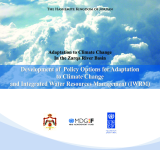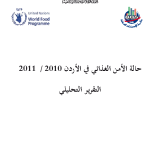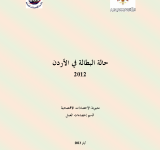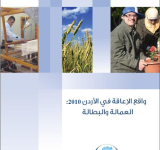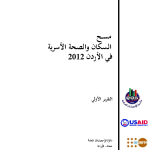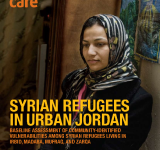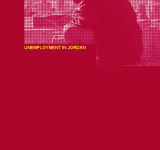The report is directed at drawing a picture of the prevailing legal and institutional frameworks of the water sector in Jordan in relation to climate change adaptation in the Zarqa River Basin (ZRB). To achieve this purpose;; three tasks were conducted;; (1) literature of pertinent documents on legislation;; administration;; regulations;; water policies and water laws were reviewed;; (2) address the gaps in the water policies in Jordan as related to climate change vulnerability;; and to raise awareness of the importance of developing climate change mitigation measures;; and (3) propose policy options for adaptation to climate change through implementation of IWRM as a tool. The objective of the revision is the assessing the appropriateness and effectiveness of the existing institutional framework regarding the climate change adaptation measures in ZRB. Combating water scarcity remains a strategic challenge that Jordan faces for augmenting its water resources.
Zarqa
يتضمن نتائج مسح الأمن الغذائي الذي أجرته الدائرة كمسح مصاحب لمسح نفقات ودخل الأسرة والذي نفذ خلال الفترة 1/4/2010 – 31/3/2011 ;; على عينة من الأسر بلغ حجمها حوالي 13 ألف أسرة ممثلة للمستوى الوطني;; الحضر والريف وكافة محافظات المملكة وعلى مستوى القضاء. يهدف هذا التقرير إلى التعرف على حالة الأمن الغذائي في الأردن;; وتحديد مناطق إنعدام الأمن الغذائي والهشاشة على مستوى الأقضية;; كما يمكن من خلال هذا التقرير التعرف على الأوضاع المعيشية لهذه الأسر كالخصائص الديموغرافية والدخل والإنفاق;; مما يساعد صانعي القرارات في استهداف الفئات المحتاجة وتوجيه الأنشطة لبناء شبكة حماية للأمن الغذائي.
استند هذا التقرير إلى بيانات مسح العمالة والبطالة الذي تنفذه دائرة الاحصاءات العامة في كل عام على أربع جولات;; ويتم دمج البيانات لتعطي مؤشرات للنتائج السنوية. وكما صممت عينة المسح بأسلوب المعاينة الطبقية من مرحلتين;; وهي عينة ممثلة على مستوى المملكة والحضر والريف;; والاقاليم والمحافظات. وبلغ حجم العينة الكلي للجولات الأربع لهذا المسح 53440 أسرة. ويهدف هذا المسح إلى التعرف على الخصائص المختلفة للمشتغلين والمتعطلين. وتبرز أهمية هذا التقرير من مجموعة المؤشرات التي يوفرها على شكل نسب مئوية وجداول تفصيلية وأشكال بيانية لإبراز الخصائص المختلفة للمتعطلين الأردنيين كالعمر والجنس والحضر والريف والمحافظات والمستوى التعليمي والحالة الزواجية وحالة سبق العمل والبطالة طويلة الأمد والعمالة المحبطة.
تقرير تحليلي للنتائج الرئيسية لمسح الإعاقة في الأردن;; الذي نفذته الدائرة خلال شهر تشرين الثاني 2010 بدعم من المجلس الأعلى لشؤون الأشخاص المعوقين. وغطى المسح عينة من الأسر بلغ حجمها حوالي (13) ألف أسرة بصورة تضمن التمثيل على مستوى المملكة والحضر والريف والأقاليم الثلاثة والمحافظات. واستندت هذه العينة إلى الإطار الذي وفرته نتائج التعداد العام للسكان والمساكن لعام 2004. ويهدف هذا التقرير بشكل رئيسي إلى إعطاء صورة عن مدى انتشار الإعاقة في الأردن;; والإعاقات الأكثر انتشاراً بين أفراد المجتمع الأردني;; ويتضمن التقرير منهجية المسح وأسلوب جمع البيانات والنتائج التحليلية.
يتمثل الهدف الرئيسي من هذا المسح في توفير بيانات شاملة وتقديرات موثوقة للمؤشرات الديموغرافية مثل الإنجاب والوفاة وتنظيم الأسرة;; وصحة وتغذية الأم والطفل بوصفها أداة لتقييم البرامج والسياسات السكانية والصحية الموجودة حالياً. تم اعتماد منهجية المسح باستخدام استمارة للأسرة واستمارة أخرى فردية;; حيث تم مقابلة 15000 أسرة وأكثر من 11000 سيدة سبق لهن الزواج وعمرهن 15-49 سنة وذلك من خلال اشهر ايلول الى كانون الأول 2012. ويقدم هذا التقرير بعض النتائج الأولية لمسح عام 2012.
This report is a baseline assessment of community-identified vulnerabilities among Syrian refugees living in Amman;; Irbid;; Madaba;; Mufraq;; and Zarqa. The purpose of this report is to identify urban Syrian refugees’ current coping mechanisms and any gaps in services available to Syrian refugees in Jordan. The research methodology is both qualitative and participatory in design;; drawing from the UNHCR tool for Participatory Assessment in Operations. This report presents only the data from household interviews;; baseline assessment;; and the follow-up focus groups conducted with community members. The number of households surveyed was 240;; with a total number of 1;;476 household members and 89 focus group participants representing 534 household members. The report proposed general recommendations and interventions to deal with the main highlighted challenges (cash assistance;; strengthening community links;; vocational training;; physical activities ...etc).
This paper aims at shedding light on the labor rights in Jordan;; particularly for those who are working in the informal sector;; through identifying the factors that impede them from enjoying such rights and;; thus;; coming up with the appropriate recommendations in this area.
This pilot study report was initiated by the European Training Foundation (ETF);; in close cooperation with the National Center for Human Resources Development (NCHRD) in Jordan;; in the framework of the ETF multiannual project Observatory Function Development in Jordan. The focus of this report is unemployment. However;; considering that unemployment information in itself should not be used or analysed in isolation from other indicators or data;; the report begins by providing an overview of the general labour market situation in Jordan. After the main data on employment by sector;; age;; gender and level of education are presented;; on the basis of the available information;; the specific cases of non-Jordanian employees and employment in the informal economy are highlighted as topics requiring special attention in the Jordanian labour market. In conclusion;; two groups of recommendations are proposed: (i) technical recommendations to main information providers for improving the quality of the information collected;; and (ii) a set of policy recommendations for tackling unemployment. These recommendations are intended to support policymakers in their commitment and willingness to adapt both the formal and informal education and training system and the whole labour market in Jordan.
